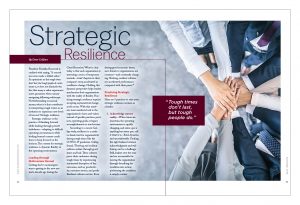Strategic Resilience
President Franklin Roosevelt is credited with saying, “A smooth sea never made a skilled sailor.” As optimistic as this tough times don’t last, but tough people do sentiment is, it does not diminish the fact that many a sailor experiences acute queasiness when circumnavigating billowing whitecaps. Notwithstanding occasional nausea, what is it that contributes to interpreting rough waters as an invitation to experience new levels of success? Strategic resilience.
Strategic resilience is the practice of thinking forward while leading through present turbulence—adapting to difficult operating circumstances while looking beyond current conditions to keep focused on the horizon. The context for strategic resilience is dynamic fluidity in the operating environment.
Leading through Multivariate Normal
Getting back to normal gave way to getting to the new normal a decade ago during the Great Recession. What is clear today is that each organization is traversing a series of temporary normals—brief chapters in their company’s story, accelerated as conditions change. Holding this dynamic perspective helps leaders synchronize their organizations with the reality of fluidity. Practicing strategic resilience requires accepting asymmetrical change as the norm. With this mindset, team members look to the organization’s vision and values instead of specific practices, products, operating goals, or legacy accomplishments as touchstones.
According to a recent Gallup study, resilience is a make-or-break trait for organizations during tough times like the COVID-19 pandemic. Gallup found, “Thriving and resilient cultures endure through good times and bad. These cultures prove their endurance during tough times by experiencing minimized disruption of key outcomes, such as productivity, customer service, and profit. Resilient cultures survive. Even during good economic times, new threats to organizations are constant—and constantly changing. Thriving, resilient cultures see accelerated performance compared with their peers.”1
Practicing Strategic Resilience
Here are 5 practices to raise your strategic resilience acumen as
a leader:
1. Acknowledge current reality—When times are uncertain, the operating environment is rapidly changing, and status quo is anything but status quo, call it what it is—fluid, dynamic, and uncomfortable. Finding the right balance between acknowledgment and wallowing can be a challenge. Still, leaders own the tone and are accountable for
moving the organization through describing the condition into action; positioning the condition is simply context.
2. Reconnect with the vision and values—The world outside your organization changes quickly. You adjust operating activities accordingly. But your business vision is focused on the horizon and remains more constant. Vision is the future-state picture an organization strives to create and results from what do we do (mission), why do we do it (purpose), and how we fulfill our mission (strategy). Values are core beliefs that define what the organization stands for. Values stand even more static than vision. In the words of Good to Great author Jim Collins, every institution has to wrestle with a vexing question: What should change and what should never change? Timeless core values should never change; operating practices and cultural norms should never stop changing. Reconnecting with your organization’s vision and values provides comfort in a storm and true north through all conditions.
3. Communicate touchpoints for stability, including a focus on the future—Leaders
are called to look beyond current conditions. That does not mean having a crystal ball. It does mean sustaining dialog around the question, what is next for our organization? With vision and values as points of stability, articulating the view toward the horizon draws attention forward, beyond current uncertainty. Engaging team members in the long game contributes to an organization’s strategic resilience.
4. Define what success looks like today, in this moment; adjust as the future unfolds—
Goals are generally established on a quarterly or annual basis. When operating conditions change rapidly, goals must be redefined in context of current, dynamic reality. Team
members perform at their best when they know what success looks like, and when expectations are aligned with dynamics of the environment. Per Gallup, “During tough times, employees need managers who reset priorities, involve them in reestablishing their goals, and constantly clarify their role relative to their coworkers.”
5. Swim with the current—A rip current is a powerful, narrow, fast-moving channel of water that starts near the shore, with a strong pull toward breaking waves. According to the National Oceanic and Atmospheric Association, if you experience rip currents when swimming at the beach, the best way to avoid drowning is to stay calm, avoid fighting the water’s movement, and swim parallel to the shore. Fighting the current exhausts the swimmer, jeopardizing the likelihood of a safe return to shore. Said another way, fighting the current is not a path to success. For leaders, this translates to understanding rip current-like changes in the business environment’s flow, quickly adapting to condition changes, and keeping sight of the vision and opportunities for accelerating progress (a.k.a., returning to shore).
Strategic resilience as a practice enables leaders to renew esprit de corps, focus their organization’s activities, and make strategy work.
Reference:
1. www.gallup.com/workplace/311270/culture-resilient-enough-survive-coronavirus.aspx?

